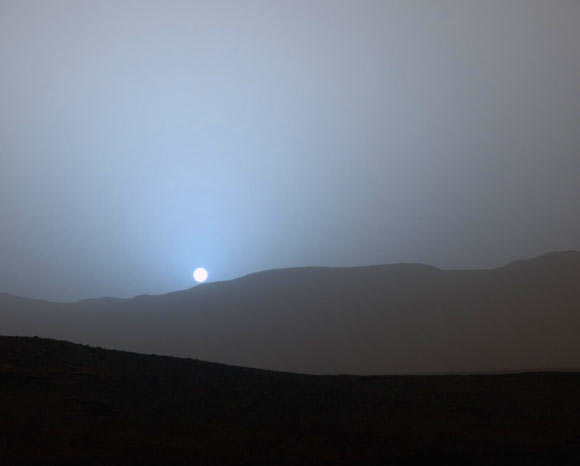This awesome-looking time-lapse sequence of the Martian sunset was created by piecing together images taken by NASA’s Mars rover Curiosity.

NASA’s Curiosity Mars rover captured this beautiful view of nightfall on the Red Planet on April 15, 2015. The red surface coloring of Mars is due to oxidized iron. At certain times of the Martian year, great dust storms occur; the large amounts of dust in the atmosphere during these storms absorb much of the incoming radiation from the Sun; this causes large temperature inversions in the Martian atmosphere. Image credit: NASA / JPL-Caltech / MSSS.
The images come from the left-eye camera of the Mast Camera (Mastcam) aboard Curiosity. The color has been calibrated and white-balanced to remove camera artifacts.
The camera sees color very similarly to what human eyes see, although it is actually a little less sensitive to blue than people are.
The imaging was done between dust storms, but some dust remained suspended high in the atmosphere of Mars.
Martian dust has fine particles that permit blue light to penetrate the atmosphere more efficiently than longer-wavelength colors.
That causes the blue colors in the mixed light coming from the Sun to stay closer to Sun’s part of the sky, compared to the wider scattering of yellow and red colors.

NASA’s Curiosity Mars rover recorded this view of the Sun on April 15, 2015 from the rover’s location in Gale Crater. The four images shown in sequence here were taken over a span of nearly seven minutes. Image credit: NASA / JPL-Caltech / MSSS.
The effect is most pronounced near sunset, when light from the Sun passes through a longer path in the atmosphere than it does at mid-day.
“The colors come from the fact that the very fine dust is the right size so that blue light penetrates the atmosphere slightly more efficiently,” explained Dr Mark Lemmon from Texas A&M University, Curiosity science team member.
“When the blue light scatters off the dust, it stays closer to the direction of the Sun than light of other colors does,” he said.
“The rest of the sky is yellow to orange, as yellow and red light scatter all over the sky instead of being absorbed or staying close to the Sun.”







